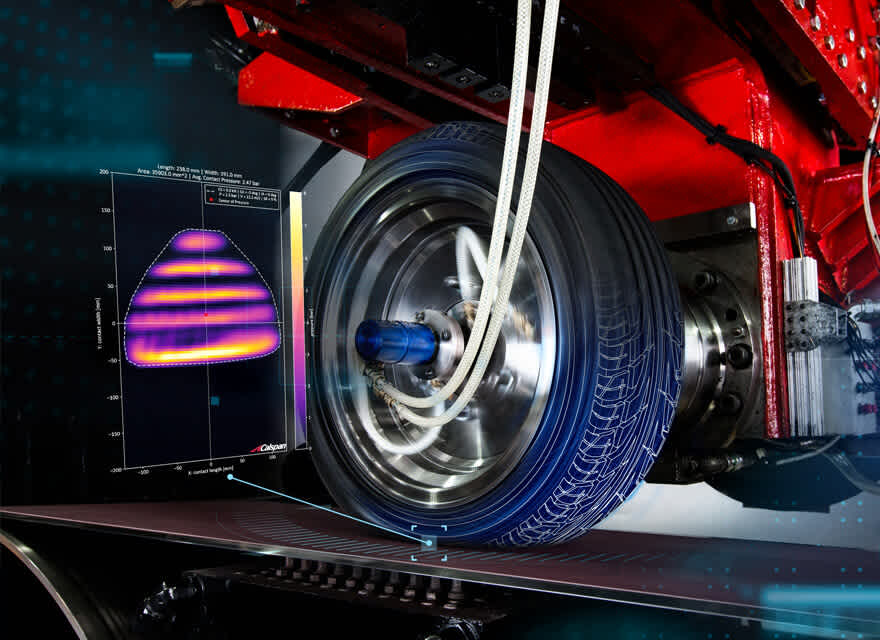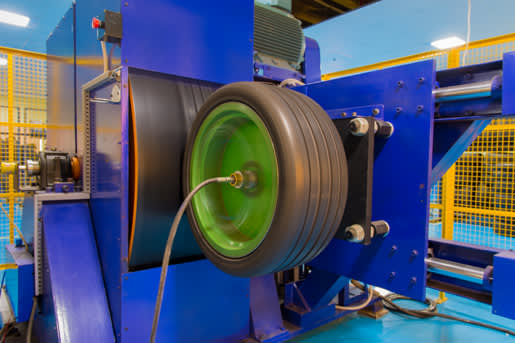Tire News & Information
Free shipping
Best price guarantee
Special pricing
Financing with Resolve
Easy returns

Tires are a critical component of every vehicle, serving as the only point of contact between the road and the car. They play a vital role in ensuring the safety, performance, and comfort of the vehicle and its occupants.
To guarantee that tires meet the necessary standards and perform as expected, they undergo rigorous testing processes before reaching the market. Tire manufacturers invest significant resources into researching, developing, and evaluating their products to deliver the best possible tires to consumers.
Understanding the tire testing process is essential for vehicle owners who want to make informed decisions when purchasing tires. By familiarizing themselves with the various tests and standards that tires must meet, consumers can select tires that suit their specific needs and ensure a safer, more reliable driving experience.
What is tire testing and why is it important?
Tire testing is a comprehensive process that evaluates the safety, performance, and durability of tires under various conditions. It involves a series of tests and assessments designed to ensure that tires meet stringent regulatory standards and manufacturer specifications.
The primary goal of tire testing is to guarantee that tires are safe for use on vehicles. Tires are subjected to a wide range of tests that simulate real-world driving conditions, including different road surfaces, weather conditions, and loading scenarios. These tests help identify potential weaknesses or defects in tire design, materials, or construction that could compromise safety.
In addition to ensuring safety, tire testing also evaluates the performance characteristics of tires. This includes aspects such as traction, handling, braking, and rolling resistance. By assessing these factors, manufacturers can develop tires that offer optimal performance for specific vehicle types and driving conditions.
Tire testing is crucial for consumers as it provides them with the information they need to make informed decisions when purchasing tires. Test results and ratings help buyers compare different tire models and brands based on their performance in various categories. This allows consumers to select tires that best suit their vehicle, driving style, and local climate.
Moreover, tire testing plays a vital role in the continuous improvement and development of tire technology. Manufacturers use the data and insights gathered from testing to refine their designs, materials, and production processes. This leads to the creation of more advanced, efficient, and safer tires over time.
In conclusion, tire testing is an essential aspect of the tire industry that ensures the safety, performance, and quality of tires available to consumers. By understanding the testing process and its importance, vehicle owners can make well-informed decisions when selecting tires for their cars, ultimately leading to a safer and more enjoyable driving experience.
Types of Tire Tests

Tire testing includes various categories, each designed to evaluate specific aspects of tire performance. These tests are essential for ensuring that tires perform safely and reliably under diverse driving conditions. They are divided into safety, performance, and durability tests.
Safety Tests
Safety tests assess a tire's resilience to different stress factors, ensuring they remain safe under challenging conditions.
- Endurance Testing: This test pushes tires to their limits to evaluate how well they manage loads and high speeds over extended periods. It ensures that tires can handle prolonged use without compromising safety.
- Accelerated Aging Tests: Tires undergo simulated long-term wear to assess their lifespan under extreme conditions. This helps determine how effectively a tire will perform over time.
- Bruise Resistance, Bead Unseating, and Rim Expansion Tests: These tests focus on specific vulnerabilities. Bruise resistance checks a tire’s ability to withstand impacts, bead unseating ensures the tire stays securely mounted, and rim expansion evaluates pressure resilience.
Performance Tests
Performance tests analyze how well a tire meets certain driving criteria.
- Rolling Resistance Tests: These tests measure the energy needed to maintain tire movement. Lower rolling resistance indicates better fuel efficiency, a critical factor for cost-conscious drivers.
- Force and Moment Tests: By simulating steering and cornering, these tests evaluate handling capabilities. Engineers use this data to enhance the tire’s responsiveness and control.
- Noise, Traction, Tread Wear, and Stopping Distance Tests: This set of tests assesses ride comfort, grip, longevity, and braking efficiency. It ensures that tires provide quiet rides, maintain traction in various conditions, wear evenly, and stop effectively.
Durability Tests
Durability tests ensure tires withstand everyday challenges.
- Carcass Durability Testing: This evaluates the tire’s core strength and structure. It ensures the tire can endure the rigors of daily use without failure.
- Compound Development Tests: These tests focus on identifying the optimal rubber formulations. The right compound can enhance grip and resistance to wear.
- Construction Analysis: Engineers examine the tire’s build and tread design to optimize performance. This involves ensuring the tire’s construction balances performance, comfort, and durability effectively.
Tire Testing Methodology
Tire testing employs two primary approaches: indoor laboratory testing and outdoor track testing. Each method provides distinct insights into tire characteristics, ensuring a thorough evaluation process before tires become available to consumers.
Indoor Laboratory Testing
Indoor laboratory testing operates in a controlled space where conditions can be meticulously managed. This setting is essential for ensuring that tests yield consistent results.
- Precision Testing Environment: Laboratories maintain stable temperatures and other environmental factors, ensuring that tire assessments aren't skewed by external influences. This stability is vital for accurate measurement.
- Advanced Equipment: Tools like dynamometers simulate driving conditions to evaluate elements such as energy efficiency and endurance. Force plates measure how tires respond to different pressures, offering insights into their structural integrity.
- Regulatory and Performance Metrics: Laboratory tests focus on specific criteria that align with industry standards. These evaluations confirm that tires adhere to necessary benchmarks, providing assurance of their quality and reliability.
Outdoor Track Testing
Outdoor track testing complements laboratory evaluations by observing tire performance in natural settings. This method provides essential insights into real-world tire behavior.
- Real-World Simulations: Tires are tested on diverse surfaces, including asphalt and gravel, to assess performance under various conditions. This testing helps predict tire behavior in everyday scenarios.
- Direct Comparisons: By employing test vehicles with standardized tires, manufacturers can effectively compare new models against existing options. This comparative analysis highlights the unique attributes of each tire.
- Driver Experience and Comfort: Outdoor tests evaluate not only the technical aspects but also the comfort and ride experience provided by the tires. Feedback from test drivers informs adjustments to enhance overall performance and driver satisfaction.
The Tire Development Process
The tire development process is an intricate journey that takes innovative ideas and turns them into reliable, high-performance products. It begins with a thorough analysis of the current market—a step known as competitive benchmarking. Manufacturers examine existing tire models to identify what sets them apart, including strengths to emulate and weaknesses to improve upon. This evaluation informs the creation of new performance targets, aiming to exceed industry standards and address specific consumer preferences.
Harnessing Advanced Technology
Cutting-edge computer modeling and simulation are integral to the modern tire development process. These tools allow engineers to craft virtual prototypes, enabling experimentation with various designs without the need for immediate physical resources. By simulating different conditions, engineers can anticipate potential performance issues such as wear patterns or heat management. This digital exploration significantly cuts down on time and resources, facilitating a more efficient development cycle.
From Prototype to Pinnacle
Once the virtual designs are optimized, the development process advances to prototyping. Multiple iterations are meticulously crafted and subjected to rigorous testing to ensure they meet the established benchmarks. Each prototype is refined based on test results, addressing any identified issues with precision. This iterative process is crucial for fine-tuning aspects like materials, tread patterns, and construction methods to achieve the optimal balance of performance, safety, and durability.
Achieving Excellence
The development journey culminates when the tire meets all performance and safety benchmarks. This includes passing stringent industry standards and internal evaluations, ensuring that the tire not only complies with regulations but also excels in real-world scenarios. Continuous testing and refinement guarantee that the final product is robust, dependable, and capable of meeting the varied demands of consumers.
How Tire Testing Benefits Consumers
Tire testing provides significant advantages for consumers by establishing clear safety and quality standards. Through meticulous evaluation processes, manufacturers ensure their tires meet these rigorous criteria, offering assurance of reliability and performance. This dedication to quality allows vehicle owners to trust that their tires have been thoroughly vetted, contributing to peace of mind on the road.
For those exploring tire options, the insights gained from testing facilitate better purchasing decisions. By subjecting tires to uniform evaluation procedures, a basis for comparing different models and brands emerges. This transparency enables consumers to choose tires that align with their specific priorities, such as longevity, handling, or ride comfort, ensuring they receive optimal value.
Additionally, tire testing helps align tire selection with individual driving and vehicle needs. As manufacturers assess various attributes like tread design and material composition, they provide data that aids consumers in selecting tires suited to their driving conditions. Whether navigating urban environments, embarking on long-distance travels, or tackling rugged terrains, drivers can leverage testing data to enhance their vehicle's performance and safety.
The insights gained from tire testing also drive technological advancements. Manufacturers use test results to refine and innovate, leading to the development of superior tires with enhanced features. This cycle of innovation benefits consumers by continually offering new tire models that improve safety standards, energy efficiency, and overall performance.
The Future of Tire Testing
Tire testing is on the brink of transformation, driven by technological advancements and the evolving needs of modern vehicles. Cutting-edge simulation and modeling techniques are becoming indispensable, providing engineers with the ability to foresee tire performance in diverse conditions before physical prototypes are even constructed. These digital advancements streamline the development process, enhancing efficiency and allowing for quicker adaptation to market demands.
Emerging tire technologies are prompting the creation of innovative testing methods. As tires integrate smart features and adaptive materials, testing protocols are evolving to address these advancements. This shift includes evaluating the impact of such technologies on traditional performance metrics and identifying new parameters for assessment. By embracing these changes, manufacturers ensure that tires remain compatible with contemporary vehicle requirements and diverse driving environments.
The growth of electric and autonomous vehicles introduces new challenges and possibilities for tire testing. These vehicles have unique requirements, like improving energy efficiency and enhancing durability to support additional weight. Testing capabilities are expanding to address these needs, focusing on how tires interact with and perform in scenarios specific to electric and autonomous vehicles. Engineers are developing specialized tests to evaluate tire compatibility with automated systems, ensuring optimal performance and integration.
Sustainability is a central focus in the future of tire testing. Manufacturers are investigating eco-friendly materials and production methods to minimize environmental impact. Testing protocols are evolving to assess the sustainability of these materials, ensuring they meet safety and performance standards. This dedication to environmental responsibility drives continuous innovation, ensuring that tire testing contributes to a more sustainable automotive future.
As tire technology continues to evolve, so too will the methods used to ensure their safety, performance, and durability. By staying informed about the tire testing process and its advancements, you can make well-informed decisions when selecting tires for your vehicle. At SimpleTire, we are committed to providing you with the highest quality tires and the information you need to make the best choice for your driving needs, so shop for tires online and let us help you find the perfect set of tires at the best price.
Ready to find the perfect tires?
Search By